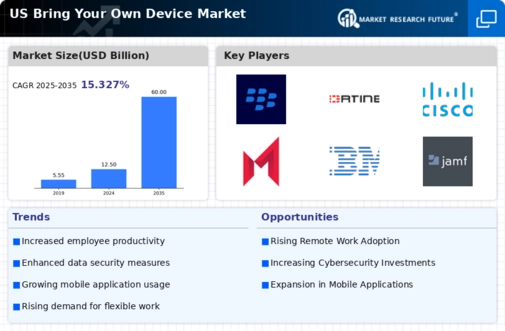Growing Trend of Digital Transformation
The ongoing trend of digital transformation is a significant driver of the bring your-own-device market. As organizations embrace digital technologies to enhance operational efficiency, the integration of personal devices into the workplace becomes increasingly prevalent. This transformation is evidenced by a report indicating that 80% of organizations are prioritizing digital initiatives. The bring your-own-device market benefits from this trend, as employees leverage their personal devices to access cloud-based applications and collaborate seamlessly. The convergence of digital transformation and personal device usage is likely to create new opportunities for growth within the bring your-own-device market, as businesses seek to harness the potential of technology.
Cost Efficiency and Resource Optimization
Cost efficiency remains a pivotal driver in the bring your-own-device market. Organizations are increasingly recognizing the financial benefits associated with allowing employees to use their personal devices. By reducing the need for company-issued hardware, businesses can save on procurement and maintenance costs. Reports suggest that companies can save up to $300 per employee annually by implementing bring your-own-device policies. This financial incentive encourages more organizations to adopt such strategies, thereby propelling the growth of the bring your-own-device market. Furthermore, resource optimization through personal device usage can lead to enhanced productivity, as employees are often more comfortable and efficient using their own technology.
Increased Focus on Data Security Regulations
The bring your-own-device market is also shaped by the heightened focus on data security regulations. With the implementation of stringent data protection laws, organizations are compelled to ensure that personal devices comply with security standards. This regulatory landscape drives businesses to adopt comprehensive bring your-own-device policies that prioritize data security. For instance, the California Consumer Privacy Act (CCPA) mandates strict data handling practices, influencing how companies manage personal devices. As organizations strive to meet these regulatory requirements, the demand for secure bring your-own-device solutions is likely to increase, further propelling the market's growth.
Rising Demand for Flexible Work Arrangements
The bring your-own-device market is experiencing a notable surge in demand for flexible work arrangements. As organizations increasingly adopt hybrid work models, employees are seeking the ability to use personal devices for work purposes. This trend is reflected in a survey indicating that approximately 70% of employees prefer to work from home at least part of the week. Consequently, businesses are compelled to adapt their policies to accommodate this preference, leading to a greater reliance on personal devices. This shift not only enhances employee satisfaction but also drives the bring your-own-device market, as companies invest in solutions that facilitate secure access to corporate resources from various devices.
Advancements in Mobile Device Management Solutions
The bring your-own-device market is significantly influenced by advancements in mobile device management (MDM) solutions. As security concerns grow, organizations are increasingly investing in MDM technologies to manage and secure personal devices accessing corporate networks. The market for MDM solutions is projected to reach $10 billion by 2026, indicating a robust growth trajectory. These solutions enable businesses to enforce security policies, manage applications, and protect sensitive data, thereby fostering a secure environment for personal device usage. Consequently, the proliferation of MDM technologies is likely to bolster the bring your-own-device market, as organizations seek to mitigate risks associated with personal device usage.
















Leave a Comment